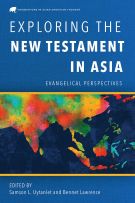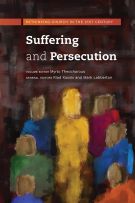| ISBN: | 9781783680474 |
|---|---|
| Imprint: | Langham Academic |
| Format: | Paperback |
| Dimensions (mm): | 229 x 152 x 17 |
| Publication Date: | 14/05/2015 |
| Pages: | 320 |
| Series: | Studies in New Testament |
| Language: | English |

Paul’s Viewpoint on God, Israel, and the Gentiles in Romans 9–11
An Intertextual Thematic Analysis
Over the years Romans 9–11 has been investigated from a variety of approaches, with one of the most prominent being an intertextual reading. However, most discussions of intertextual studies on this section of Romans fail to adequately address Paul’s discourse patterns and that of his Jewish contemporaries with regard to God, Israel, and the Gentiles.
Adapting Lemke’s linguistic intertextual thematic theory, this study uses a methodological control to analyze the discourse patterns in Romans 9–11. Through this analysis the author demonstrates the divergence of Paul’s viewpoints on several typical Jewish issues, which suggests that his discontinuities from his Jewish contemporaries are obvious and sometimes radical. It is apparent that Romans 9–11 not only provides a self-presentation of Paul as a Mosaic prophet figure, but overall it appears as a prophetic discourse, reinforcing the notion that Paul’s message comes from divine authority.
Endorsements
Xiaxia Xue has written an important and challenging book on intertextuality in Romans 9–11. . . she fully embraces both the dialogical nature of intertexts and the role that a robust theory of linguistics can play in engaging such interactive voices. I warmly recommend this book as providing a major step forward both in method and in understanding how Paul creates his argument in this important part of his letter to the Romans. This is a book to be read and contemplated.
Stanley E. Porter
President, Dean and Professor of New Testament,
Roy A. Hope Chair in Christian Worldview,
McMaster Divinity College
Table of Contents
- Abstract
- Abbreviations
- Chapter One
- Introduction
- 1.1 Situating Romans
- 1.1.1 Paul’s Own Situation
- 1.1.2 The Situation of the Christians in Rome
- 1.2 A Survey of the Literature of Romans 9–11
- 1.2.1 Survey of General Studies of Romans 9–11
- 1.2.1.1 Theological-exegesis Approach
- 1.2.1.2 Literary Approach
- 1.2.2 Intertextual Research on Romans 9–11
- 1.2.2.1 Focus on Motifs
- 1.2.2.2 Focus on Paul’s Role in his Understanding of Scripture
- 1.3 The Objective of this Study and its Thesis
- 1.4 Value of this Research
- 1.5 Outline of the Present Study
- Chapter Two
- Research Methodology: An Intertextual Thematic Analysis
- 2.1 Introduction
- 2.2 Lemke’s Concept of Intertextuality
- 2.2.1 Introduction
- 2.2.2 Lemke’s Concept of Thematic Formations
- 2.2.2.1 The Definition
- 2.2.2.2 Its Constructions
- 2.2.3 Lemke’s Concept of Intertextual Thematic Formation
-
- 2.2.3.1 The Definition
- 2.2.3.2 Relations of Intertextual Thematic Formations
- 2.2.3.3 Heteroglossic Voices and Projection Clauses
- 2.2.4 Thematic Organization
- 2.2.5 Multiple Voices and Intertexts
- 2.3 Evaluation of Lemke’s Intertextual Thematic Model
- 2.4 An Adaptation of Lemke’s Intertextual Thematic Analysis to our Analytical Procedure
- 2.4.1 An Adaptation of Lemke’s Intertextual Thematic Analysis
- 2.4.2 Analytical Procedure
- 2.5 Conclusion
- Chapter Three
- An Intertextual Thematic Analysis of Romans 9:1–29: The Nature of God and Who are God’s People
- 3.1 Introduction
- 3.2 Romans 9:1–5
- 3.2.1 Presentational Meaning
- 3.2.2 Scriptural Voices
- 3.2.3 Thematic-organizational Meaning
- 3.2.4 Multiple Voices: Viewpoints of Paul’s Jewish Contemporaries on Intercession for Israel
- 3.3 Romans 9:6–13
- 3.3.1 Presentational Meaning: God’s Promise and Who are God’s People
- 3.3.2 Scriptural Voices
- 3.3.3 Thematic-organizational Meaning
- 3.3.4 Multiple Voices: Viewpoints of Paul’s Jewish Contemporaries on God’s Word and Human’s Doing
- 3.4 Romans 9:14–29
- 3.4.1 Presentational Meaning: God’s Authority, God’s Mercy and God’s People
- 3.4.2 Scriptural Voices
- 3.4.3 Thematic-organizational Meaning
- 3.4.4 Multiple Voices: Paul’s Jewish Contemporaries’ Viewpoints on God’s Nature and God’s People
- 3.5 Conclusion
- Chapter Four
- Paul’s Critique of Israel: An Intertextual Thematic Analysis of Romans 9:30–10:21
- 4.1 Introduction
- 4.2 Romans 9:30–10:4
- 4.2.1 Presentational Meaning: Israel’s Failure to Attain Righteousness
- 4.2.2 Scriptural Voices
- 4.2.3 Thematic-organizational Meaning
- 4.2.4 Multiple Voices: Paul’s Jewish Contemporaries Viewpoints on Law, Righteousness, and Faith
- 4.3 Romans 10:5–13
- 4.3.1 Presentational Meaning
- 4.3.2 Scriptural Voices
- 4.3.3 Thematic-organizational Meaning
- 4.3.4 Multiple Voices: Paul’s Jewish Contemporaries’ Viewpoints on the Scope of Salvation
- 4.3.5 Conclusion
- 4.4 Romans 10:14–21
- 4.4.1 Presentational Meaning
- 4.4.2 Scriptural Voices
- 4.4.3 Thematic-organizational Meaning
- 4.4.4 Multiple Voices: Paul’s Jewish Contemporaries’ Viewpoints Concerning Israel’s Sin in Relation to the Gentiles
- 4.4.5 Conclusion
- 4.5 Conclusion
- Chapter Five
- Paul’s Warning to the Gentiles and the Salvation of All God’s People: An Intertextual Analysis of Romans 11
- 5.1 Introduction
- 5.2 Romans 11:1–10
- 5.2.1 Presentational Meaning: The Remnant of Israel
- 5.2.2 Scriptural Voices
- 5.2.3 Thematic-organizational Meaning
- 5.2.4 Multiple Voices: Paul’s Jewish Contemporaries’ Viewpoints on God’s Faithfulness and Israel’s Sinfulness
- 5.3 Romans 11:11–32
- 5.3.1 Presentational Meaning
- 5.3.2 Scriptural Voices
- 5.3.3 Thematic-organizational Meaning
- 5.3.4 Multiple Voices: Paul’s Jewish Contemporaries’ Viewpoints on the Role of the Gentiles in the Salvation of Israel
- 5.4 Conclusion
- 5.5 Additional Note: Verses 33–36
- Chapter Six
- Conclusion
- Appendix 1
- Appendix 2
- Chart for Romans 9:1-5
- Appendix 3
- Charts for Romans 9:6–13
- Appendix 4
- Charts for Romans 9:14–29
- Appendix 5
- Charts for Romans 9:30–10:4
- Appendix 6
- Charts for Romans 10:4–13
- Appendix 7
- Baruch Text
- Appendix 8
- Charts for Romans 10:14–21
- Appendix 9
- Charts for Romans 11:1–10
- Appendix 10
- Charts for Romans 11:11–32
- Appendix Endnotes
- Bibliography







